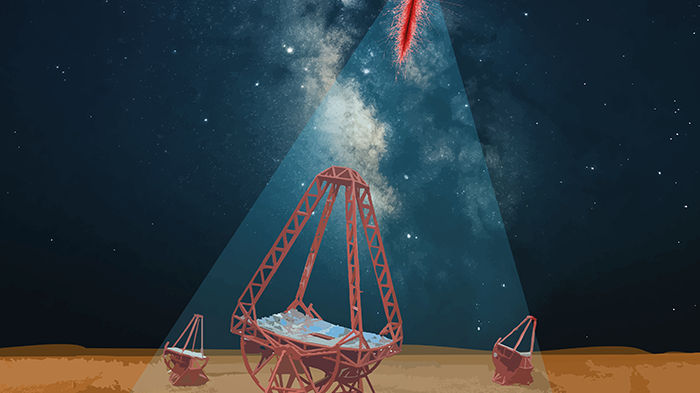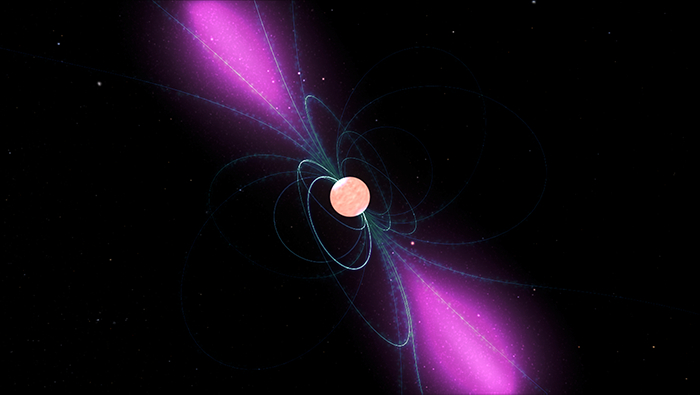Scientists find highest energy cosmic ray electrons ever seen
"Understanding these cosmic rays allows us to unveil big particle accelerators in the universe that are often associated with the most violent phenomena."

After over a decade of meticulous data collection, scientists at the H.E.S.S. observatory — which stands for "High Energy Stereoscopic System" and is located in Namibia — have made a groundbreaking discovery. They've detected the most energetic cosmic electrons ever observed, unlocking new avenues in our understanding of the universe.
"Cosmic rays are a century-old mystery," Mathieu de Naurois, a researcher at the French National Centre for Scientific Research and deputy director of the H.E.S.S. collaboration, told Space.com.
First reported in 1912 by Austrian physicist Victor Hess, cosmic rays were discovered after a series of balloon ascents meant to explore ionizing radiation that was first detected on an electroscope. However, after reaching an altitude of 5,300 meters, Hess unveiled a natural source of high-energy particles from space. Today, we call those particles cosmic rays.
Now, H.E.S.S. scientists are excited because they’ve detected the highest energy electrons and positrons to date (a positron is like the "opposite" of an electron because it has the mass of an electron, but is positively charged like a proton), which make up one component of high-energy cosmic rays.The finding is exciting because it provides tangible evidence of extreme cosmic processes unleashing colossal amounts of energy.
Related: Earth got hammered by cosmic rays 41,000 years ago due to a weak magnetic field
"Understanding these cosmic rays allows us to unveil big particle accelerators in the universe that are often associated with the most violent phenomena: the explosion of stars; very compact objects with huge gravitational and electromagnetic fields, such as neutron stars and pulsars; cataclysmic mergers; and black holes," said de Naurois.
The cool part is, because electrons at this energy lose energy quickly, the team believes they must be coming from relatively nearby. "In the vicinity of our solar system, there [are] very efficient cosmic accelerators of electrons," de Naurois said. "Within a few hundred light-years, there are many stars, with the nearest ones typically lying two light-years from the Earth. We would therefore also expect to have a few ‘dead stars’ in this region, such as pulsars or supernova remnants, which could be the sources of these electrons."
Breaking space news, the latest updates on rocket launches, skywatching events and more!
Detecting these high energy electrons and positrons with energies of several teraelectronvolts — higher than any particle accelerators on Earth are able to achieve — has been particularly challenging for a couple of reasons.
Firstly, galactic magnetic fields cause electrons to deviate from a straight path, arriving on Earth from seemingly random directions. Secondly, space-based instruments are too small to capture enough of these particles, partly due to the particles' uneven energy distribution in space.
In other words, cosmic ray sources accelerate particles gradually, with higher-energy particles being more likely to escape their systems. Because reaching the highest energies takes time, this leads to an abundance of low-energy particles and progressively fewer particles at higher energy levels. "At high energies, the cosmic ray flux falls rapidly, meaning space instruments collect too few of them," de Naurois explained.
On the other hand, however, ground-based telescopes that detect cosmic rays indirectly have a difficult time differentiating cosmic ray electrons from countless other types of cosmic rays bombarding Earth's atmosphere.
"H.E.S.S., in contrast, has a huge effective area, making it particularly suitable to study the high energy part of the electron spectrum," de Naurois said.
The H.E.S.S. Observatory, consisting of five large telescopes spread across an area of about the size of a football field, was designed to capture atmospheric showers that emit Cherenkov radiation. This radiation occurs when high-energy particles collide with the Earth's atmosphere, creating particle showers that the telescopes can detect and analyze.

Though its main purpose is to detect gamma rays and find their sources, the team repurposed the data to search for these high energy cosmic ray electrons. "The algorithm used here is based on a pixel-by-pixel comparison, using sophisticated statistical modeling — specifically likelihood analysis — between a pre-calculated model and the images recorded by the camera," said de Naurois.
Originally, the algorithm was adapted to detect electrons, which are subtly different from gamma rays. They also had to be able to differentiate the electrons from background signals. And, because electrons are rare in the data, the algorithm had to be adjusted to reject other cosmic ray particles by applying stricter criteria, but this also resulted in fewer electrons being detected.
To improve accuracy, "every telescope observation was thoroughly simulated, providing a deeper understanding of how the instruments behave," said de Naurois.
This resulted in an unparalleled set of statistical data for analyzing cosmic-ray electrons. The team confirmed that the electron energy spectrum extends up to at least 40 TeV, which is 400 times higher than the energy-detection capabilities of Earth-based accelerators. A sharp "break" in the spectrum around 1 TeV indicates that electrons at this energy lose energy rapidly within the Milky Way, suggesting, as de Naurois stated, that they originate from relatively nearby sources.
"The sharpness of this break implies that only a few, or possibly just one, cosmic source is responsible for these electrons," he added. "If multiple sources were involved, the spectrum would be smoother, with breaks occurring at different energy levels. The best candidates are relatively old supernovas, or strong stellar winds from WR stars [the bare cores of initially massive stars whose original hydrogen-rich envelope has been removed by stellar winds], but there are other possibilities that we cannot rule out."
The team says its analysis not only provides crucial data, but also data that will act as a benchmark for future studies.

A chemist turned science writer, Victoria Corless completed her Ph.D. in organic synthesis at the University of Toronto and, ever the cliché, realized lab work was not something she wanted to do for the rest of her days. After dabbling in science writing and a brief stint as a medical writer, Victoria joined Wiley’s Advanced Science News where she works as an editor and writer. On the side, she freelances for various outlets, including Research2Reality and Chemistry World.
